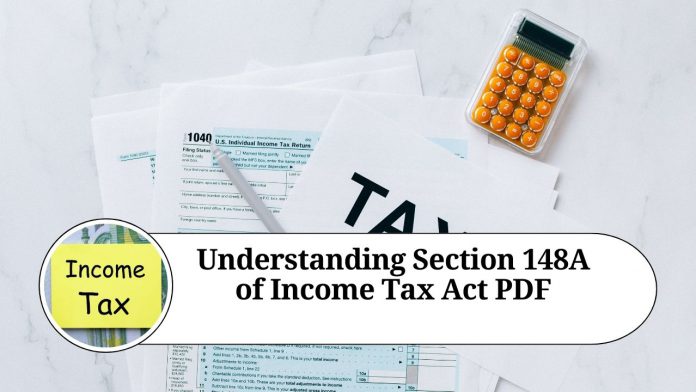Section 148A of the Income Tax Act, 1961 was introduced by the Finance Act, 2021 with an aim to enhance transparency and accountability in taxation matters. This section empowers the Central Board of Direct Taxes (CBDT) to issue directions to Income Tax Authorities to ensure timely and accurate compliance of tax laws. Let’s understand more about this section in detail.
What is Section 148A of Income Tax Act PDF?
Section 148A of the Income Tax Act, 1961 states that the CBDT may issue directions to Income Tax Authorities to ensure compliance with the provisions of the Income Tax Act within a stipulated time frame. The section further empowers the CBDT to prescribe the procedure and conditions for issuing such directions.
The primary objective of this section is to enable the CBDT to effectively monitor and regulate the compliance of taxpayers with the Income Tax Act. The section provides a mechanism to ensure timely and accurate compliance, thereby reducing the possibility of tax evasion and promoting transparency in taxation matters.
Key Features of Section 148A
- Empowers the CBDT: Section 148A empowers the CBDT to issue directions to Income Tax Authorities for ensuring compliance with the provisions of the Income Tax Act.
- Time-bound Compliance: The directions issued by the CBDT must be complied with within a stipulated time frame, as prescribed by the CBDT.
- Procedure and Conditions: The CBDT may prescribe the procedure and conditions for issuing directions under Section 148A.
- Applicability: Section 148A is applicable to all taxpayers, including individuals, companies, and other entities.
- Penalty for Non-Compliance: Non-compliance with the directions issued under Section 148A may attract penalties and other legal consequences.
Benefits of Section 148A
- Enhanced Transparency: Section 148A promotes transparency in taxation matters by ensuring timely and accurate compliance with the provisions of the Income Tax Act.
- Better Monitoring: The CBDT can effectively monitor and regulate the compliance of taxpayers with the Income Tax Act, thereby reducing the possibility of tax evasion.
- Reduced Litigation: The mechanism provided under Section 148A can help reduce litigation related to taxation matters by ensuring timely compliance.
Conclusion
Section 148A of the Income Tax Act, 1961 is a step towards enhancing transparency and accountability in taxation matters. The section empowers the CBDT to issue directions to Income Tax Authorities to ensure timely and accurate compliance with the provisions of the Income Tax Act. It is a welcome move towards reducing tax evasion and promoting transparency in taxation matters. As taxpayers, it is important to comply with the directions issued under this section to avoid penalties and other legal consequences.
Read more useful content:
- section 145 of income tax act
- section 10e of income tax act
- section 9 of the income tax act
- section 94b of income tax act
- section 206aa of income tax act
Frequently Asked Questions (FAQs)
Q1. What is Section 148A of the Income Tax Act, 1961?
A1. Section 148A of the Income Tax Act, 1961 empowers the Central Board of Direct Taxes (CBDT) to issue directions to Income Tax Authorities to ensure compliance with the provisions of the Income Tax Act within a stipulated time frame.
Q2. When was Section 148A introduced?
A2. Section 148A was introduced by the Finance Act, 2021.
Q3. Who does Section 148A apply to?
A3. Section 148A applies to all taxpayers, including individuals, companies, and other entities.
Q4. What is the objective of Section 148A?
A4. The primary objective of Section 148A is to enable the CBDT to effectively monitor and regulate the compliance of taxpayers with the Income Tax Act, thereby reducing the possibility of tax evasion and promoting transparency in taxation matters.
Q5. Can the CBDT prescribe the procedure and conditions for issuing directions under Section 148A?
A5. Yes, the CBDT may prescribe the procedure and conditions for issuing directions under Section 148A.
Q6. What is the time frame within which the directions issued under Section 148A must be complied with?
A6. The time frame within which the directions issued under Section 148A must be complied with will be prescribed by the CBDT.
Q7. What are the consequences of non-compliance with the directions issued under Section 148A?
A7. Non-compliance with the directions issued under Section 148A may attract penalties and other legal consequences.
Q8. How can taxpayers ensure compliance with the directions issued under Section 148A?
A8. Taxpayers can ensure compliance with the directions issued under Section 148A by carefully reviewing the directions and ensuring that they comply within the prescribed time frame.
Q9. Will Section 148A help reduce litigation related to taxation matters?
A9. Yes, the mechanism provided under Section 148A can help reduce litigation related to taxation matters by ensuring timely compliance.
Q10. Is Section 148A a welcome move towards enhancing transparency and accountability in taxation matters?
A10. Yes, Section 148A is a welcome move towards enhancing transparency and accountability in taxation matters.




















